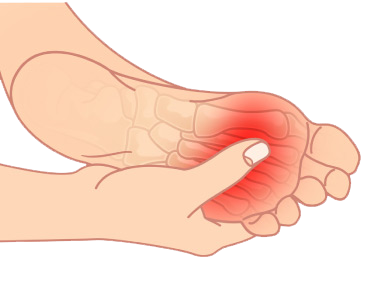Plantar Fasciitis Causes and Treatment
Plantar fasciitis is pain and inflammation of the plantar fascia, a thick band of connective tissue that runs along the heel to the toes and helps to maintain the arch of the foot. In this article, we will discuss various plantar fasciitis treatments to explore.
Common symptoms include pain along the arches of the foot or at the heel. In some cases, there could also be sharp pain upon first stepping out of bed or from sitting. This comes from increased standing, walking or activity.

Plantar Fasciitis Causes
A variety of factors can cause plantar fasciitis.
Foot Type & Mechanics
Flat, flexible feet can result in overpronation, which places an excess stretch on the plantar fascia with every step. High arched feet, on the other hand, have a naturally tighter plantar fascia. This results in increased tension along the tissue with gait.
Activities
Work duties that require long hours of standing or walking, intense activity or carrying heavy loads can increase strain on the plantar fascia.
Footwear
Weak, unstructured footwear with a lack of cushioning does not provide the foot with enough support, hence placing more stress upon the foot to maintain stability. Wearing footwear such as high heels also places the tissue at a shorter length which increases tightness.
Individual
Very tight musculature can create excess pull and strain on the connection tissues. Weight gain also leads to increased load on the plantar fascia with weight bearing, and age may result in flattening of the arches and thus stretch on the tissue.
Plantar Fasciitis Treatments
There are many plantar fasciitis treatments that can help with plantar fasciitis pain.
A consistent treatment plan including all these treatments would allow the plantar fascia to heal quicker, and to help prevent re-occurrence.
Custom Foot Orthotics
Depending on the assessment of the foot, custom orthotics can help to provide arch support to a fallen arch to support the plantar fascia or to improve pressure distribution and cushioning in a higher arched foot.
Proper Footwear
Make sure the shoes have a strong base and heel counter and cushioning to help with shock absorption. You should not be able to easily twist the shoes; it should have good torsional strength.
This applies to sandals and slippers as well. Some brands to consider are Sole and Birkenstocks, where the arch is built into the footbed. Or brands such as Naot or Portofino, which have removable footbeds to replace with custom orthotics.
Physiotherapy
Physiotherapy and other modes of treatment such as massage therapy and acupuncture would help to rehabilitate the muscle to release tension and increase strength.
Stretches & Massages
This is very important to address tight musculature. Basic calf stretches and stretching of the plantar fascia should be done daily.
Medication
Anti-inflammatory pills can help with reducing inflammation and to address pain. At a more severe level, cortisone injections may be suggested by your doctor.
Night Splint
Due to the dropping of the forefoot during sleep or rest, the plantar fascia is placed in a shortened position during which it heals. The newly formed tissue is however not yet strong enough in the morning, hence tearing and resulting in sharp pain in the morning.
A night splint holds the foot up and keeps the muscles and tissues lengthened so it heals while it is stretched out. This is a very effective tool for morning pain.
Talk To A Specialist
As we mentioned earlier, the ideal way to treat this condition is to use a combination of plantar fasciitis treatments that work best for you. To learn more about what should be in your treatment plan, talk to a pedorthist at Kintec location nearest to you!
Sorry, the comment form is closed at this time.